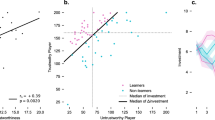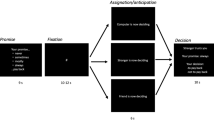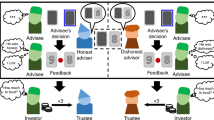Abstract
Exploring neural markers that predict trust behavior may help us to identify the cognitive process underlying trust decisions and to develop a new approach to promote interpersonal trust. It remains unknown how trust behavior may be predicted early in the decision process. We used electrophysiology to sample the brain activity while participants played the role of trustor in an iterative trust game. The results showed that during the trust generation stage, the trust condition led to higher frontocentral beta band activity related to cognitive inhibition compared to the distrust condition (item level). Moreover, individuals with higher frontocentral beta band activity were more likely to perform trust choices at the single-trial level (individual level). Furthermore, after receiving reciprocity feedback on trialn-1, compared to the betrayal feedback and the distrust choice, the frontocentral beta band oscillation had a stronger predictive effect regarding trust choices on trialn. These findings indicate that beta band oscillations during the decision generation stage contribute to subsequent trust choices.






Similar content being viewed by others
References
Balliet D, Van Lange PAM. Trust, conflict, and cooperation: A meta-analysis. Psychol Bull 2013, 139: 1090–1112.
Glaeser EL, Laibson DI, Scheinkman JA, Soutter CL. Measuring trust. Q J Econ 2000, 115: 811–846.
Haas BW, Ishak A, Anderson IW, Filkowski MM. The tendency to trust is reflected in human brain structure. Neuroimage 2015, 107: 175–181.
Carré JM, Baird-Rowe CD, Hariri AR. Testosterone responses to competition predict decreased trust ratings of emotionally neutral faces. Psychoneuroendocrinology 2014, 49: 79–83.
Hooper JJ, Sutherland CAM, Ewing L, Langdon R, Caruana N, Connaughton E et al. Should I trust you? autistic traits predict reduced appearance-based trust decisions. Br J Psychol 2019, 110: 617–634.
Biasiucci A, Franceschiello B, Murray MM. Electroencephalography. Curr Biol 2019, 29: 80–85.
Karamzadeh N, Medvedev A, Azari A, Gandjbakhche A, Najafizadeh L. Capturing dynamic patterns of task-based functional connectivity with EEG. Neuroimage 2013, 66: 311–317.
Buzsaki G, Logothetis N, Singer W. Scaling brain size, keeping timing: evolutionary preservation of brain rhythms. Neuron 2013, 80: 751–764.
Buzsaki G, Watson BO. Brain rhythms and neural syntax: implications for efficient coding of cognitive content and neuropsychiatric disease. Dialogues Clin Neurosci 2012, 14: 345–367.
Gross J. Analytical methods and experimental approaches for electrophysiological studies of brain oscillations. J Neurosci Methods 2014, 228: 57–66.
Berg J, Dickhaut J, McCabe K. Trust, reciprocity, and social-history. Games Econ Behav 1995, 10: 122–142.
Johnson ND, Mislin AA. Trust games: A meta-analysis. J Econ Psychol 2011, 32: 865–889.
Platt ML. Neural correlates of decisions. Curr Opin Neurobiol 2002, 12: 141–148.
Kilner JM, Friston KJ, Frith CD. Predictive coding: an account of the mirror neuron system. Cogn Process 2007, 8: 159–166.
Thornton MA, Weaverdyck ME, Tamir DI. The social brain automatically predicts others’ future mental states. J Neurosci 2019, 39: 140–148.
Fu C, Yao X, Yang X, Zheng L, Li J, Wang Y. Trust game database: behavioral and EEG data from two trust games. Front Psychol 2019, 10: 2656.
Wang Y, Jing Y, Zhang Z, Lin C, Valadez EA. How dispositional social risk-seeking promotes trusting strangers: evidence based on brain potentials and neural oscillations. J Exp Psychol Gen 2017, 146: 1150–1163.
Wang Y, Zhang Z, Jing Y, Valadez EA, Simons RF. How do we trust strangers? The neural correlates of decision making and outcome evaluation of generalized trust. Soc Cogn Affect Neurosci 2016, 11: 1666–1676.
Aimone JA, Houser D. What you don’t know won’t hurt you: a laboratory analysis of betrayal aversion. Exp Econ 2012, 15: 571–588.
Bohnet I, Zeckhauser R. Trust, risk and betrayal. J Econ Behav Organ. 2004, 55: 467–484.
Rand DG. Cooperation, Fast and Slow:Meta-analytic evidence for a theory of social heuristics and self-interested deliberation. Psychol Sci 2016, 27: 1192–1206.
Zeckhauser R, Bohnet I, Greig F, Herrmann B. Betrayal aversion: evidence from Brazil, China, Oman, Switzerland, Turkey, and the United States. Am Econ Rev 2008, 98: 294–310.
Engel AK, Fries P. Beta-band oscillations – signaling the status quo?. Curr Opin Neurobiol 2010, 20: 156–165.
Huster RJ, Enriquez-Geppert S, Lavallee CF, Falkenstein M, Herrmann CS. Electroencephalography of response inhibition tasks: functional networks and cognitive contributions. Int J Psychophysiol 2013, 87: 217–233.
Declerck CH, Boone C, Emonds G. When do people cooperate? The neuroeconomics of prosocial decision making. Brain Cogn 2013, 81: 95–117.
Delgado MR, Frank RH, Phelps EA. Perceptions of moral character modulate the neural systems of reward during the trust game. Nat Neurosci 2005, 8: 1611–1618.
King-Casas B, Tomlin D, Anen C, Camerer CF, Quartz S, Montague PR. Getting to know you: Reputation and trust in a two-person economic exchange. Science 2005, 308: 78–83.
Maurer C, Chambon V, Bourgeois-Gironde S, Leboyer M, Zalla T. The influence of prior reputation and reciprocity on dynamic trust-building in adults with and without autism spectrum disorder. Cognition 2017, 172: 1–10.
Fouragnan E, Chierchia G, Greiner S, Neveu R, Avesani P, Coricelli G. Reputational priors magnify striatal responses to violations of trust. J Neurosci 2013, 33: 3602–3611.
Faul F, Erdfelder E, Lang AG, Buchner A. G*Power 3: A flexible statistical power analysis program for the social, behavioral, and biomedical sciences. Behav Res Methods 2007, 39: 175–191.
Thielmann I, Hilbig BE. Trust: An integrative review from a person-situation perspective. Rev Gen Psychol 2015, 19: 249–277.
Chen J, Zhong J, Zhang Y, Li P, Zhang A, Tan Q et al. Electrophysiological correlates of processing facial attractiveness and its influence on cooperative behavior. Neurosci Lett 2012, 517: 65–70.
Pak R, McLaughlin AC, Bass B. A multi-level analysis of the effects of age and gender stereotypes on trust in anthropomorphic technology by younger and older adults. Ergonomics 2014, 57: 1277–1289.
Delorme A, Makeig S. EEGLAB: an open source toolbox for analysis of single-trial EEG dynamics including independent component analysis. J Neurosci Methods 2004, 134: 9–21.
Bigdely-Shamlo N, Mullen T, Kothe C, Su K, Robbins K. The PREP pipeline: standardized preprocessing for large-scale EEG analysis. Front Neuroinform 2015, 9: 16.
Makeig S, Debener S, Onton J, Delorme A. Mining event-related brain dynamics. Trends Cogn Sci 2004, 8: 204–210.
Knutson B, Rick S, Wimmer E, Prelec D, Loewenstein G. Neural predictors of purchases. Neuron 2007, 53: 147–156.
Price CJ, Ramsden S, Hope TMH, Friston KJ, Seghier ML. Predicting IQ change from brain structure: a cross-validation study. Dev Cogn Neurosci 2013, 5: 172–184.
Raudenbush SW, Bryk AS. Hierarchical linear models: applications and data analysis methods. 2 ed. 2002, Thousand Oaks, CA: Sage.
Engle-Warnick J, Slonim RL. The evolution of strategies in a repeated trust game. J Econ Behav Organ 2004, 55: 553–573.
Hoffman M, Yoeli E, Nowak MA. Cooperate without looking: why we care what people think and not just what they do. Proc Natl Acad Sci U S A 2015, 112: 1727–1732.
Koscik TR, Tranel D. The human amygdala is necessary for developing and expressing normal interpersonal trust. Neuropsychologia 2011, 49: 602–611.
Lemmers-Jansen ILJ, Krabbendam L, Veltman, DJ, Fett AKJ. Boys vs. girls: Gender differences in the neural development of trust and reciprocity depend on social context. Dev Cogn Neurosci 2017, 25: 235–245.
Badre D, Kayser AS, D’Esposito M. Frontal cortex and the discovery of abstract action rules. Neuron 2010, 66: 315–326.
Wolff A, Gomez-Pilar J, Nakao T, Northoff G. Interindividual neural differences in moral decision-making are mediated by alpha power and delta/theta phase coherence. Sci Rep 2019, 9: 4432.
Ai SZ, Yin Y, Chen Y, Wang C, Sun Y, Tang X et al. Promoting subjective preferences in simple economic choices during nap. Elife 2018, 7: e40583.
Hu L, Iannetti GD. Neural indicators of perceptual variability of pain across species. Proc Natl Acad Sci U S A 2019, 116: 1782–1791.
Wagner J, Makeig S, Gola M, Neuper C, Müller-Putz GR. Distinct β band oscillatory networks subserving motor and cogntive control during gait adaptation. J Neurosci 2016, 29: 12675–12685.
Axelrod R. Effective choice in the prisoner’s dilemma. J Conflict Resolut 1980, 24: 3–25.
Zhao K, Smillie LD. The role of interpersonal traits in social decision making: exploring sources of behavioral heterogeneity in economic games. Pers Soc Psychol Rev 2015, 19: 277–302.
Bodmer B, Mueckschel M, Roessner V, Beste C. Neurophysiological variability masks differences in functional neuroanatomical networks and their effectiveness to modulate response inhibition between children and adults. Brain Struct Funct 2018, 223: 1797–1810.
Fareri DS, Chang LJ, Delgado MR. Effects of direct social experience on trust decisions and neural reward circuitry. Front Neurosci 2012, 6: 148.
Bernal B, Altman N. Neural networks of motor and cognitive inhibition are dissociated between brain hemispheres: an fMRI study. Int J Neurosci 2009, 119: 1848–1880.
Bornstein AM, Khaw MW, Shohamy D, Daw ND. Reminders of past choices bias decisions for reward in humans. Nat Commun 2017, 8: 15958.
Cisek P. Cortical mechanisms of action selection: the affordance competition hypothesis. Philos Trans R Soc Lond B Biol Sci 2007, 362: 1585–1599.
Cisek P, Pastor-Bernier A. On the challenges and mechanisms of embodied decisions. Philos Trans R Soc Lond B Biol Sci 2014, 369: 315–318.
Pennartz CMA, Ito R, Verschure PFMJ, Battaglia FP, Robbins TW. The hippocampal-striatal axis in learning, prediction and goal-directed behavior. Trends Neurosci 2011, 34: 548–559.
Zhang YY, Xu L, Liang ZY, Wang K, Hou B, Zhou Y et al. Separate neural networks for gains and losses in intertemporal choice. Neurosci Bull 2018, 34: 725–735.
Li J, Shen J, Liu S, Chauvel M, Yang W, Mei J et al. Responses of patients with disorders of consciousness to habit stimulation: a quantitative EEG study. Neurosci Bull 2018, 34: 691–699.
Buser T. Digit ratios, the menstrual cycle and social preferences. Games Econ Behav 2012, 76: 457–470.
Acknowledgements
This work was supported by the National Natural Science Foundation of China (71942002 and 31771238) and the National Social Science Foundation of China (19ZDA361).
Author information
Authors and Affiliations
Corresponding authors
Ethics declarations
Conflict of Interests
The authors declared no conflicts of interest with respect to the authorship or the publication of this article.
Rights and permissions
About this article
Cite this article
Wang, Y., Yang, X., Tang, Z. et al. Hierarchical Neural Prediction of Interpersonal Trust. Neurosci. Bull. 37, 511–522 (2021). https://doi.org/10.1007/s12264-021-00628-5
Received:
Accepted:
Published:
Issue Date:
DOI: https://doi.org/10.1007/s12264-021-00628-5




